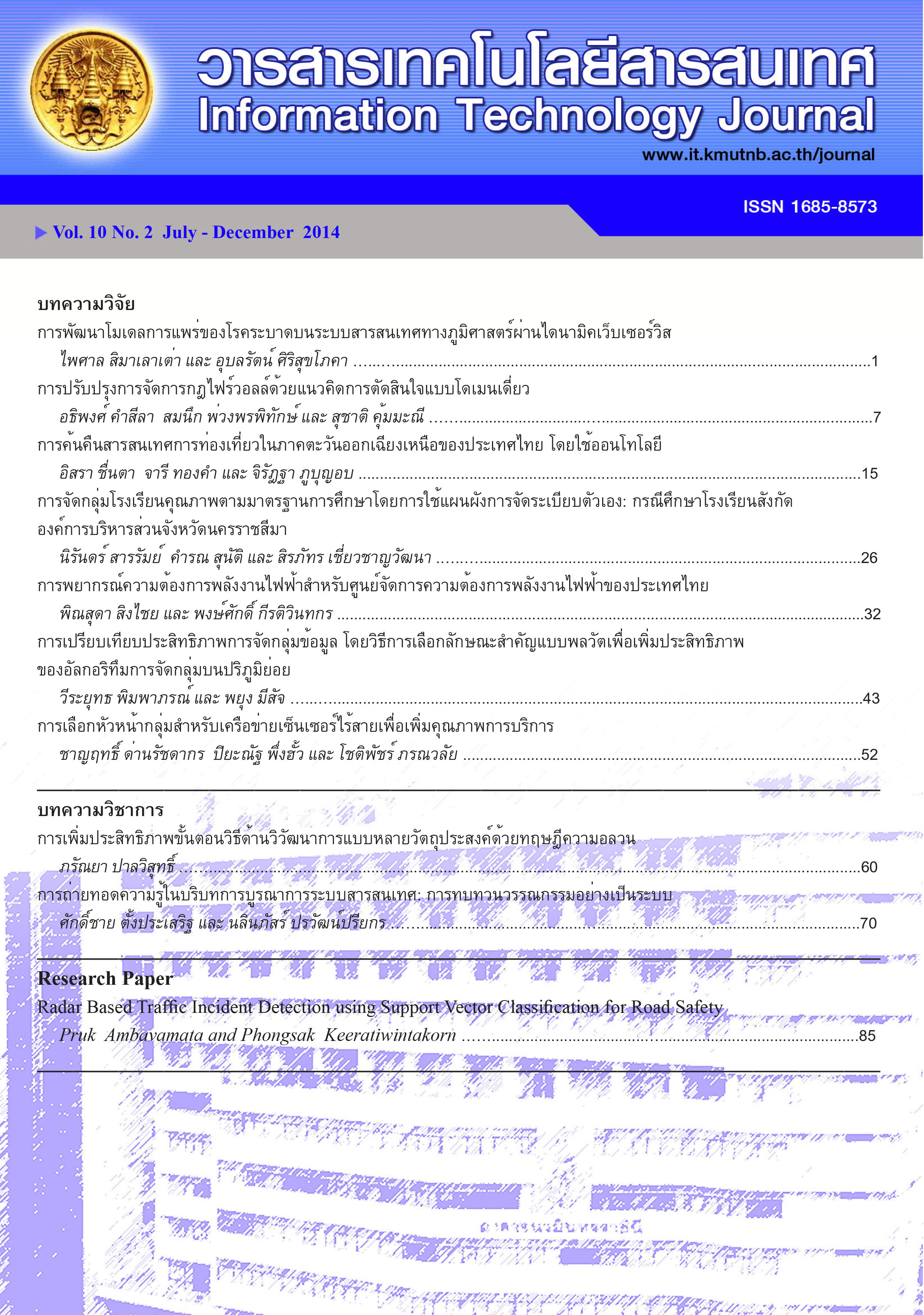การพัฒนาโมเดลการแพร่ของโรคระบาดบนระบบสารสนเทศทาง ภูมิศาสตร์ผ่านไดนามิคเว็บเซอร์วิส
Main Article Content
Abstract
งานวิจัยนี้มีวัตถุประสงค์เพื่อพัฒนาโมเดลการแพร่ของ โรคระบาดบนระบบสารสนเทศทางภูมิศาสตร์ผ่านไดนามิค เว็บเซอร์วิส โดยแบ่งการทดลองออกเป็น 3 ส่วน คือ ส่วนแรก เป็นการนำเข้าข้อมูลเกี่ยวกับผู้ป่วยโรคไข้หวัดใหญ่และ โรคไข้เลือดออก ผ่านส่วนติดต่อกับผู้ใช้ที่มีการออกแบบ ให้ใช้งานได้ง่าย ส่วนที่สอง เป็นการทดสอบการให้บริการข้อมูลด้วยไดนามิคเว็บเซอร์วิสโดยการเลือกเฉพาะข้อมูลที่ต้องการมาสร้างเป็นโครงสร้างข้อมูลสำหรับให้บริการ และส่วนที่สามเป็นการทดสอบการนำเสนอโมเดลการแพร่ระบาด บนระบบสารสนเทศภูมิศาสตร์ ซึ่งข้อมูลที่นำเสนอสามารถ เปลี่ยนแปลงได้ตามเงื่อนไขที่กำหนด เช่น พื้นที่ที่มีการ แพร่ระบาด ลักษณะการแพร่ระบาด ปัจจัยในการแพร่ระบาด เป็นต้น โดยสามารถเลือกช่วงเวลาในการแพร่ระบาดทำให้ ทราบถึงพื้นที่และขอบเขตของการแพร่ระบาด เพื่อใช้ใน การวางแผนควบคุมการแพร่ระบาดต่อไป ผลการดำเนินการ ใช้การประเมินคุณภาพของระบบจากผู้เชี่ยวชาญทุกด้าน อยู่ในระดับดี โดยมีค่าเฉลี่ยอยู่ที่ 4.30 และค่าเบี่ยงเบน มาตรฐานเท่ากับ 0.53 โมเดลดังกล่าวควรนำไปพัฒนาต่อ เพื่อให้สามารถรองรับการทำงานกับโรคหลายชนิดมากขึ้น
Development of Disease Dispersion Model on Geographic Information System via Dynamic Web Service
Paisam Simalotao and Ubonrat Sirisukpoca
A disease dispersion model on the Geographic Information System (GIS) is developed, via a dynamic web service, based on three parts. In the first part, data of patients with influenza and dengue fever are designed for easy-to-use interface. In the second part, the dynamic web service is tested by selecting only the desired data to build a data structure for the service. The proposed disease dispersion model on GIS is tested in the last part. The information presented can be varied according to the pandemic area epidemic characteristics, and factors related to disease spread. Selecting period of time can provide the epidemic areas and the extents. The quality assessment of the system by experts received “good” grade with average and standard deviation of 4.30 and 0.53. This model should be further developed to be compatible to other diseases.

